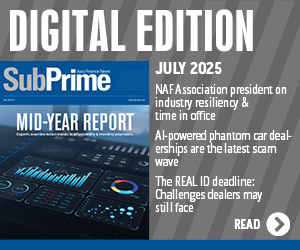Credit Acceptance Discusses 3 Main Factors Influencing Today’s Subprime Market
Normal
0
false
false
false
EN-US
X-NONE
X-NONE
MicrosoftInternetExplorer4
SOUTHFIELD, Mich. — After closing a quarter when the company
posted strong gains in both consolidated and adjusted net income, Credit
Acceptance Corp. leaders reflected on how they arrived at those first-quarter
achievements.
Three topics kept returning to the conversation when Credit
Acceptance conducted a conference call on Tuesday to discuss its Q1
performance: a competitive environment, readily available capital and
lengthening loan terms.
But first, the numbers.
Credit Acceptance reported that its first-quarter
consolidated net income came in at $60.6 million or $2.48 per diluted share,
for the three-month span that ended March 31. A year earlier, the company's consolidated
net income totaled $50.3 million or $1.92 per diluted share.
The company also highlighted that its adjusted net income, a
non-GAAP financial measure, for the quarter was $58.8 million or $2.41 per
diluted share. Those figures are up from $49.0 million or $1.86 per diluted
share Credit Acceptance posted a year ago.
Early last month, the company reported that its unit volume
softened in the first quarter despite a 21.2-percent jump in the number of
active dealers. SubPrime Auto Finance News published more details here.
When presented with investment analyst questions on Tuesday,
Credit Acceptance chief executive officer Brett Roberts first responded by
assessing the competitive landscape. Analysts from Experian Automotive and CNW
Research have previously mentioned how much subprime approvals have steadily climbed
in the past year.
In fact, CNW shared April data this morning that indicated the
number of subprime used-vehicle buyers skyrocketed by nearly 36 percent to
934,130 purchasers. That figure is much higher than what the industry recorded
in April of last year when a total of 686,928 buyers fell into subprime.
Furthermore, in the deep subprime market (buyers
with FICO scores 550), CNW spotted a 51.47-percent increase in April compared to
a year ago.
"We've seen a lot of new entrants into the market, and a lot
of companies that have typically played at a higher credit tier have dipped
down," Roberts said. "But there are hundreds of companies out there. It's not
just one or two companies that drive the market. There's a lot of capital out
there so we're going to have a lot of competition until something else happens
to those capital flows."
Unlike 2009 for example when credit seized as the recession
gripped the economy, Credit Acceptance has funds available.
"Today we have lots of capital so we'll typically take a
smaller return on a larger loan in order to deploy more capital," Roberts said.
"We look at it on a profit-per-unit basis rather than a return basis. When we
enter a period where we're restricted on capital, then we think about it
differently."
Another element Credit Acceptance is analyzing differently
nowadays is loan terms. While Experian Automotive highlighted earlier this year
that loans terms industry-wide hit record lengths at more than 60 months,
Credit Acceptance is also watching its consumer terms stretch.
Four years ago, the company indicated that average contracts
last 36 months. In the first quarter of this year, the average jumped to 48
months.
"If you look back to when I started with the company 20
years ago, I think the longest term we would write was 24 months and
everything, if I remember right, had to have 25 percent down," Roberts said. "We
started from that point and gradually expanded our policies to be less
restrictive as we gathered data over time. So over the last 20 years, we've
accumulated data on 36-month loans and 48-month loans and 60-month loans, and
we've gradually moved our policies out as we've felt more comfortable that we
could price that business properly."
Roberts acknowledged there are "hundreds" of lenders that
will provide financing to deep subprime buyers, those consumers with credit
scores in the 550 range and lower. But he is confident Credit Acceptance can
compete.
"We do business with about 10 percent of the dealers so
there is plenty of market out there," Roberts said. "How many of those we're
able to enroll in our program and how quickly we're able to do that all depends
on execution. We just have to see how those numbers play out. We're definitely
pleased to see solid dealer growth through the first quarter."
When asked how Credit Acceptance can continue to bolster its
active dealer base along with originations, Roberts pointed to the strategy the
company already has in place.
"Some of the more obviously things are just signing up more
dealers, which we work toward that by expanding our field sales force," Roberts
said. "How much business we do is a function of everything we do as a company.
Of course the dealers get 80 percent of what we collect once they pay back the
advance. So improving our collections will improve how many deals we get from
dealers. Improving our service on the origination side will increase how much
business we get. It's everything we do."
Reaction to CFPB Guidance on Indirect Auto Lending
Analysts also asked Roberts for his reaction to the guidance
issued in March by the Consumer Financial Protection Bureau regarding potential
discrimination in connection with indirect auto lending. A breakdown of the
CFPB's guidance is available here along with reaction from several industry associations
here.
"I think it's too early to say," Roberts said. "The industry
has put out a response to that. We're very much in touch with our industry
association. (Charles Pearce), who is our chief legal officer, is very active
in the association so we'll just continue to work with the CFPB until we get
something that's clear. I don't see it having a large impact on our program."
Nick Zulovich can be reached at nzulovich@subprimenews.com. Continue the conversation with SubPrime Auto Finance News on LinkedIn and Twitter.


